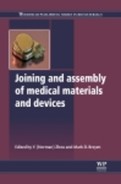0%
29Chapters
0-1Hours read
0kTotal Words
Book Description
As medical devices become more intricate, with an increasing number of components made from a wide range of materials, it is important that they meet stringent requirements to ensure that they are safe to be implanted and will not be rejected by the human body. Joining and assembly of medical materials and devices provides a comprehensive overview of joining techniques for a range of medical materials and applications.Part one provides an introduction to medical devices and joining methods with further specific chapters on microwelding methods in medical components and the effects of sterilization on medical materials and welded devices. Part two focuses on medical metals and includes chapters on the joining of shape memory alloys, platinum (Pt) alloys and stainless steel wires for implantable medical devices and evaluating the corrosion performance of metal medical device welds. Part three moves on to highlight the joining and assembly of medical plastics and discusses techniques including ultrasonic welding, transmission laser welding and radio frequency (RF)/dielectric welding. Finally, part four discusses the joining and assembly of biomaterial and tissue implants including metal-ceramic joining techniques for orthopaedic applications and tissue adhesives and sealants for surgical applications.
Joining and assembly of medical materials and devices is a technical guide for engineers and researchers within the medical industry, professionals requiring an understanding of joining and assembly techniques in a medical setting, and academics interested in this field.
- Introduces joining methods in medical applications including microwelding and considers the effects of sterilization on the resulting joints and devices
- Considers the joining, assembly and corrosion performance of medical metals including shape memory alloys, platinum alloys and stainless steel wires
- Considers the joining and assembly of medical plastics including multiple welding methods, bonding strategies and adhesives
Table of Contents
- Cover image
- Title page
- Table of Contents
- Copyright
- Contributor contact details
- Woodhead Publishing Series in Biomaterials
- Part I: Fundamentals of joining and assembly in medical materials and devices
- Part II: Joining and assembly of medical metals
- Chapter 5: Micro-welding of shape-memory alloys
- Chapter 6: Joining of platinum (Pt) alloy wires to stainless steel wires for electronic medical devices
- Chapter 7: Evaluating the corrosion performance of metal medical device welds
- Abstract:
- 7.1 Introduction
- 7.2 Measurements of corrosion
- 7.3 Direct measurements of corrosion current
- 7.4 Considerations when gathering corrosion data
- 7.5 Test sample preparation
- 7.6 Instrumentation and equipment
- 7.7 Interpretation of data
- 7.8 Mitigations for weld corrosion
- 7.9 Future trends
- 7.10 Sources of further information
- Chapter 8: Laser hermetic welding of implantable medical devices
- Chapter 9: Validating hermeticity in welded metallic implantable medical devices
- Part III: Joining and assembly of medical plastics
- Chapter 10: Overview of welding methods for medical plastics
- Abstract:
- 10.1 Introduction
- 10.2 Fundamental processes of plastics welding
- 10.3 Medical plastics and weldability
- 10.4 Part and Joint Design
- 10.5 Processes with external heating
- 10.6 Processes with internal heating
- 10.7 Processes with implant welding
- 10.8 Potential impacts from other manufacturing processes
- 10.9 Special applications for welding of medical plastics
- Chapter 11: Ultrasonic welding of medical plastics
- Abstract:
- 11.1 Introduction
- 11.2 Ultrasonic-welding processes fundamentals
- 11.3 Ultrasonic-welding process parameters and control
- 11.4 Weldability
- 11.5 Horn design
- 11.6 Part and joint design
- 11.7 Process optimization
- 11.8 Other specific applications
- 11.9 Troubleshooting
- 11.10 Advantages and limitations
- Chapter 12: Radio frequency (RF)/dielectric welding of medical plastics
- Abstract:
- 12.1 Introduction
- 12.2 Dielectric heating fundamentals
- 12.3 Dielectric welding/sealing process description and process parameters
- 12.4 Key factors affecting the sealing process and seal quality
- 12.5 Weldability
- 12.6 Testing approaches for seals and the dielectric sealing process
- 12.7 RF welding process advantages, limitations and future trends
- Chapter 13: Transmission laser welding strategies for medical plastics
- Chapter 14: Bonding strategies and adhesives for joining medical device components
- Chapter 10: Overview of welding methods for medical plastics
- Part IV: Joining and assembly of biomaterial and tissue implants
- Chapter 15: Advanced metal–ceramic joining techniques for orthopaedic applications
- Chapter 16: Tissue adhesives and sealants for surgical applications
- Abstract:
- 16.1 Introduction
- 16.2 Principles of tissue adhesives and sealants
- 16.3 Definitions and general considerations
- 16.4 Mechanisms of bonding
- 16.5 Application methods
- 16.6 Synthetic bioresorbable sealants
- 16.7 Commercial resorbable synthetic sealants and adhesives
- 16.8 Commercial resorbable bio-derived sealants and adhesives
- 16.9 Commercial biostable bio-derived sealants and adhesives
- 16.10 Commercial biostable synthetic sealants and adhesives
- 16.11 Conclusion
- Chapter 17: Antibacterial adhesives for bone and tooth repair
- Chapter 18: Testing bond strength: the case of dental biomaterials
- Index
